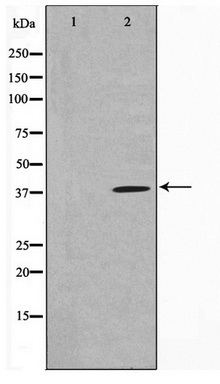RANKL (TNFSF11) Rabbit Polyclonal Antibody
Frequently bought together (2)
Transient overexpression lysate of tumor necrosis factor (ligand) superfamily, member 11 (TNFSF11), transcript variant 1
USD 436.00
Other products for "TNFSF11"
Specifications
| Product Data | |
| Applications | WB |
| Recommended Dilution | WB: 1:500-1:3000 |
| Reactivities | Human, Mouse |
| Host | Rabbit |
| Clonality | Polyclonal |
| Immunogen | The immunogen for anti-TNFSF11 Antibody: A synthesized peptide derived from human TNFSF11 |
| Formulation | PBS, pH 7.4,50% glycerol. |
| Concentration | lot specific |
| Purification | Affinity-chromatography |
| Conjugation | Unconjugated |
| Storage | Store at -20°C as received. |
| Stability | Stable for 12 months from date of receipt. |
| Predicted Protein Size | 40 kDa |
| Gene Name | tumor necrosis factor superfamily member 11 |
| Database Link | |
| Background | TNFSF11 Cytokine that binds to TNFRSF11B/OPG and to TNFRSF11A/RANK. Osteoclast differentiation and activation factor. Augments the ability of dendritic cells to stimulate naive T-cell proliferation. May be an important regulator of interactions between T-cells and dendritic cells and may play a role in the regulation of the T-cell-dependent immune response. May also play an important role in enhanced bone-resorption in humoral hypercalcemia of malignancy. |
| Synonyms | CD254; hRANKL2; ODF; OPGL; OPTB2; RANKL; sOdf; TRANCE |
| Note | TNFSF11 antibody detects endogenous levels of total TNFSF11 |
| Reference Data | |
| Protein Families | Druggable Genome, Transmembrane |
| Protein Pathways | Cytokine-cytokine receptor interaction |
Documents
| Product Manuals |
| FAQs |
| SDS |
{0} Product Review(s)
0 Product Review(s)
Submit review
Be the first one to submit a review
Product Citations
*Delivery time may vary from web posted schedule. Occasional delays may occur due to unforeseen
complexities in the preparation of your product. International customers may expect an additional 1-2 weeks
in shipping.






























































































































































































































































 Germany
Germany
 Japan
Japan
 United Kingdom
United Kingdom
 China
China



